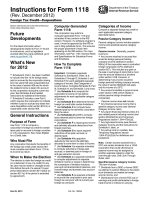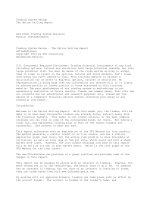2012 Nonprofit Communications Trends Report pdf
Bạn đang xem bản rút gọn của tài liệu. Xem và tải ngay bản đầy đủ của tài liệu tại đây (1.5 MB, 22 trang )
2012
Nonprofit Communications
Trends Report
1
1
Introduction
Welcome to our second annual survey of what
nonprofits predict for their communications in the
coming year.
The trends you’ll find in this report come from 1,288
nonprofits in 42 countries, with 82% from the U.S.
and 6% from Canada. The survey was conducted
online in November 2011.
We asked nonprofits . . .
•
In what shape is your marketing plan for 2012?
•
Which communications tools do you see as very
important, somewhat important, and least
important to you in 2012?
•
• Infographics of the key trends in this report
• Trends by regions of the U.S. and Canada
• Trends by mission of the organization
• Additional analysis of what excites and scares
nonprofit communicators in the coming year
I hope you find the 2012 Nonprofit Communications
Trends report enlightening!
What excites you about your work in 2012?
•
As we continue to review the data from the survey,
in early 2012 we will release
How often do you plan to email the typical
person on your email list? How often do you
plan to send direct mail?
•
Available in January 2012
What scares you about your work in 2012?
In this year’s survey, we also asked nonprofits to
categorize themselves by budget size, location, and
mission. We’ve noted some of the interesting
variations in their answers based on budget in this
report.
Kivi Leroux Miller
President, Nonprofit Marketing Guide.com
2
Summary of Survey Results
This report is based
on a survey of 1,288
nonprofits in
November 2011
conducted at
Nonprofit Marketing
Guide.com.
Nonprofits with
budgets under $1
million represent 54%
of survey participants;
46% have budgets
over $1 million.
Nonprofits in 42
countries completed
the survey, with 82%
from the United
States and 6% from
Canada.
Only ¼ of nonprofits (24%) have a
written and approved marketing plan
for 2012. 59% have a written plan or
informal notes for themselves only, not
formally approved by leadership.
Email marketing and websites will be
the most important communications
tools for nonprofits in 2012, followed by
Facebook; print (newsletters, direct
mail); in-person events; and media
relations/PR. These are the Big Six of
nonprofit communications.
The importance of social media channels
like Facebook, Twitter, and blogging
held steady between 2011 and 2012,
with only video gaining in
importance.
Download this report and
additional infographics and analysis at
NonprofitMarketingGuide.com/2012trends
Monthly emailing is the most popular
frequency for nonprofits at 43%,
followed by every other week at 19%
and quarterly at 14%. More than threequarters of nonprofits (78%) plan to
email their typical supporters at least
monthly.
Quarterly direct mail is the most
popular frequency for nonprofits at
39%, followed by twice a year at 31%.
Only 12% expect to send direct mail
to their typical supporters at least
monthly.
Nonprofit communicators are excited
about investing in new websites,
having real plans in place for the first
time, integrating communications
channels to increase effectiveness,
and using social media to reach new
supporters.
Nonprofit communicators are scared
about vying for supporters’ attention;
trying something new, especially
social media; the slow economy and
lack of investment in marketing; and
being overworked and burning out.
3
Marketing Plans
When you put a plan in writing, you increase the likelihood that you’ll follow through on it.
Yet only ¼ (24%) of nonprofits have a written and approved marketing plan for
2012.
Three-fifths of nonprofit communicators (59%) have written plans or informal notes for
themselves only, not formally approved by leadership. Seven percent will just do what they
did last year. Ten percent have plans only in their heads.
The $5 million budget mark
appears to be where the shift
between informal and formal
planning begins to take place. For
organizations with budgets under $5
million, only 20% have a written and
approved plan for 2012. Of those
with budgets over $5 million, 42%
had a formal and approved plan.
4
Communications Tools
Nonprofits have more communications tools available to them than ever before. This survey
listed 14 options and asked participants to select up to three that were most important,
somewhat important, and least important.
Email Marketing - E-Newsletters
Print (Newsletters-Direct Mail)
Website
Blog
Video (YouTube etc.)
Photo Sharing
Audio (e.g. Podcasts)
Media Relations/PR
Paid Advertising
Phone Calls/Phone Banks
Texting
In-Person Events
The Big Six: Most Important Nonprofit Communications Channels
As in 2011, nonprofits identified as “very” important the same top six communications
channels for 2012. Websites and email marketing are, by far, most important, followed by
print (newsletter, direct mail); in-person events; Facebook; and media relations/PR.
Texting, audio (e.g. podcasts), and photo sharing are the least important communications
tools for nonprofits in 2012.
5
Communications Tools
Communications
Tool
Very
Important
Somewhat
Important
Least
Important
Website
68%
25%
1%
Email Marketing - E-Newsletters
67%
22%
1%
Print (Newsletters-Direct Mail)
38%
29%
9%
In-Person Events
38%
28%
4%
31%
49%
3%
Media Relations/PR
28%
29%
6%
Blog
9%
18%
20%
Video (YouTube etc.)
6%
24%
12%
5%
29%
22%
Paid Advertising
5%
12%
48%
Phone Calls/Phone Banks
5%
14%
34%
Photo Sharing
1%
5%
30%
Audio (e.g. podcasts)
1%
3%
49%
Texting
1%
3%
57%
Source: NonprofitMarketingGuide.com/2012trends
6
Relative Importance of Communications Tools to Nonprofits in 2012
Source: NonprofitMarketingGuide.com/2012trends
7
Communications Tools
Online Communication Dominates
When you combine the “very important” and “somewhat important” rankings, you see
instantly how online marketing tools continue to dominate, with 93% of participants
identifying their website as being a very or somewhat important tool, and 89%
identifying email marketing the same way. While these rankings are down from 2011,
when websites ranked at 96% and email at 94%, these two channels are still clearly in first
and second place.
As it did in 2011, Facebook follows in third place, with 80% identifying it as a very or
somewhat important communications tool, trumping more traditional forms of nonprofit
communication, such as print marketing (67%), in-person events (66%), and media
relations/PR (57%).
These channels – website, email, Facebook, print, in-person events, and media
relations/PR – are the Big Six for nonprofit communicators.
Smaller Orgs More Social; Larger Ones More Traditional
Smaller organizations are more “social” both online and in person. They rated
Facebook, Twitter, blogging, and in-person events higher than larger organizations.
Larger organizations rely more heavily on traditional channels like print and
media relations than smaller nonprofits.
Not surprisingly, smaller organizations prefer low-cost channels like email
and social networking sites, while larger nonprofits are more likely than smaller
ones to identify as very important more expensive channels like paid advertising,
phone banks, and print.
8
Most Important Communications Tools for Nonprofits in 2012
Combining “Very” and “Somewhat” Important Rankings
9
10
Social Media
With the exception of Facebook, other social media tools fall far behind other
communications channels for nonprofits. Only 34% of participants identified Twitter as very or
somewhat important, followed by online video (30%), blogging (27%), photo sharing (6%), and
audio-podcasting (4%). It’s worth noting, however, that while these tools ranked lower
individually, many nonprofits do rely on blogging, video, photo sharing and podcasting to keep
their website, email, and Facebook pages fresh and engaging.
Video gained in importance for nonprofits from 2011 to 2012, while Facebook, Twitter, and
blogging held steady.
11
Emailing Supporters
Monthly emailing to a typical person on an email list is the most popular frequency for
nonprofits at 43%, followed by every other week at 19% and quarterly at 14%. More than threequarters of nonprofits (78%) plan to email their typical supporters at least monthly, up
from 75% in 2011.
Not surprisingly, the more important a nonprofit believes email to be as a communications
tool, the more frequently they expect to email supporters: 85% of the nonprofits that ranked
email as a “very important” tool will email at least monthly (up from 81% in 2011), with 40%
emailing every other week or more (up from 35% in 2011). On the other hand, of those ranking
email as only “somewhat important,” 66% will email at least monthly and only 22% will email
every other week or more.
12
13
Sending Direct Mail
Quarterly direct mail to the typical person on the mailing list is the most popular
frequency for nonprofits at 39%, followed by twice a year at 31%. Only 12% expect to send
direct mail to their typical supporters at least monthly. This is compared to 78% of nonprofits
who expect to email their typical supporters at least monthly.
Half of nonprofits (51%) will send direct mail to their supporters at least four times a year, which
is down from 55% last year.
14
To hear participants speak about the coming year in their own words, we asked two open-ended
questions:
What Excites You?
What excites you most about your work in 2012?
What scares you most about your work in 2012?
While the answers to both questions fall across a wide spectrum, a few trends are clear, as seen in
the word clouds and some representative samples below.
What’s Exciting Nonprofit Communicators
Investing in New Websites
Many nonprofits have realized that old brochure-style websites don’t work anymore and have
invested in making their websites more user-focused and interactive.
“Finishing and launching our new website which will provide us with a better way to
highlight our aid work and generate more interest in and donations for our projects.”
“Having a new website to help integrate all of our online marketing.”
“Promoting and working with our new website.”
Having Real Plans in Place for the First Time
Communicators are thrilled that their organizations are finally taking marketing and
communications seriously and are developing marketing plans, as well as fully incorporating
marketing into their strategic plans.
“Finally evolving our communications strategy and having a real plan!”
“Setting goals that all parties will buy into.”
“Boldly going where no one has gone before . . . we have never developed a marketing plan,
ever. Until now!”
15
What Excites You?
Integrating Communications Channels to Increase Effectiveness
Nonprofits are learning how much more effective their marketing and fundraising can be when
messages are shared in an integrated way across multiple communications channels.
“We are launching a multi-channel marketing strategy. It’s the first for our 46-year old
nonprofit.”
“Moving from ‘old school’ communications (phone, print) to a primarily technology-based
communications strategy (email, social media, website).”
“Continuing our work to use multiple channels to reach our key stakeholders.”
Using Social Media to Reach New Supporters
Nonprofits continue to explore ways to use social media to reach beyond their usual groups of
supporters.
“We are moving into mobile, SMS, and integrating it with social media.”
“Launch of an online social community that ties into our database.”
“Incorporating social media more into our communications plan.”
16
17
What’s Scary to Nonprofit Communicators
What Scares You?
Vying for Supporters’ Attention
Despite having more ways to communicate (and perhaps because of that), many nonprofits feel
that it is harder than ever to get the attention of their supporters.
“Ever-growing competition for the ears, minds, and hearts on the Internet.”
“Trying to get and keep people’s attention in an environment where the average person
spends less than a second on our message.”
“How to get people’s attention when there is already so much noise out there.”
Fear of Trying Something New, Especially Social Media
While nonprofits are excited about social media’s potential, they are also leery about it, because
they don’t fully understand how to use it. Many organizations are also simply more comfortable
with what they’ve always done, and anything new – including social media – is daunting.
“Internal trepidation about new strategies.”
“My organization doesn’t value new ways of communication, like social media.”
“The lack of understanding of new social media tools and the hesitance of some to accept
their use in the work environment.”
18
What Scares You?
The Slow Economy and Lack of Investment in Marketing
Many nonprofits have yet to fully integrate marketing into their programming or fundraising
strategies, and therefore see communications activities as an optional “feel good” expenditure,
especially when revenues are down.
“Our communications are nearly 100% volunteer supported. Expectations are high and need
to be more realistic. We can’t support a lot more unless money and staff are allocated.”
“Lack of resources and losing funding to cover marketing, communications, and fundraising
costs.”
“It’s only me, with free online tools, and no budget to pull this off.”
Being Overworked and Burning Out
Tied to a lack of financial resources is the lack of time that many nonprofit staff responsible for
marketing are given. Too-long to-do lists are a chronic problem throughout the nonprofit sector,
but especially in communications, where new communications channels seem to spring up weekly.
“Time is running away. I have too many projects and it’s getting worse. It scares me that I
will just walk away.”
“Staff resource limitations don’t allow us to do everything we think we need to do.”
“Too many projects, with too little staff time to devote, and too little internal technical
knowledge for some of the upgrades we are undertaking.”
19
20
Coming Next . . .
Download this report and
additional infographics and analysis at
NonprofitMarketingGuide.com/2012trends
More Trends
Free Webinar
Watch for additional data from
this survey later in January
2012, including
• Infographics of the key trends
in this report
• Trends by regions of the U.S.
and Canada
• Trends by mission of the
organization
• Additional analysis of what
excites and scares nonprofit
communicators in the coming
year.
Attend live on January 5,
or watch the recording later.
21
About Us
At Nonprofit Marketing Guide, we give small
nonprofits and communications departments of
one the tips and training they need to do smart,
savvy marketing, communications, and
fundraising for their good causes.
Get your free membership to our Learning Center
at NonprofitMarketingGuide.com/members
Keep up with the latest news, resources, and
advice on Kivi’s Nonprofit Communications Blog
at NonprofitMarketingGuide.com/blog
Download this report and graphics from it at
NonprofitMarketingGuide.com/2012trends
This work is licensed
under a Creative
Commons AttributionNonCommercialShareAlike 3.0
License
22









